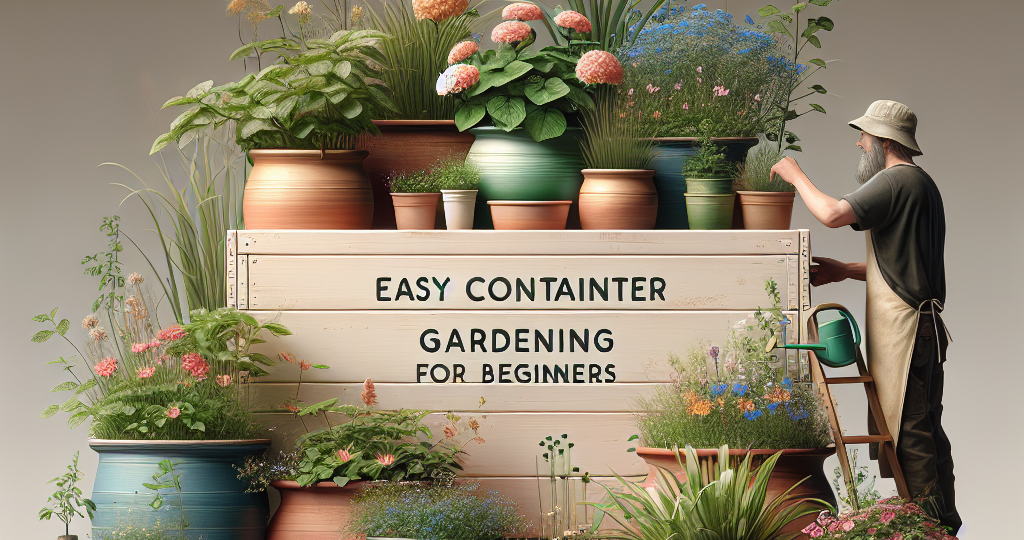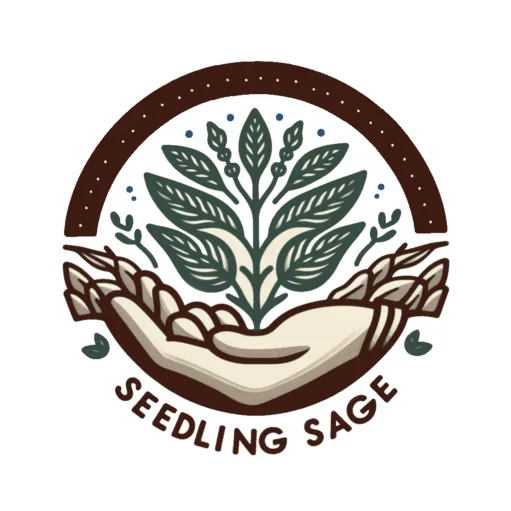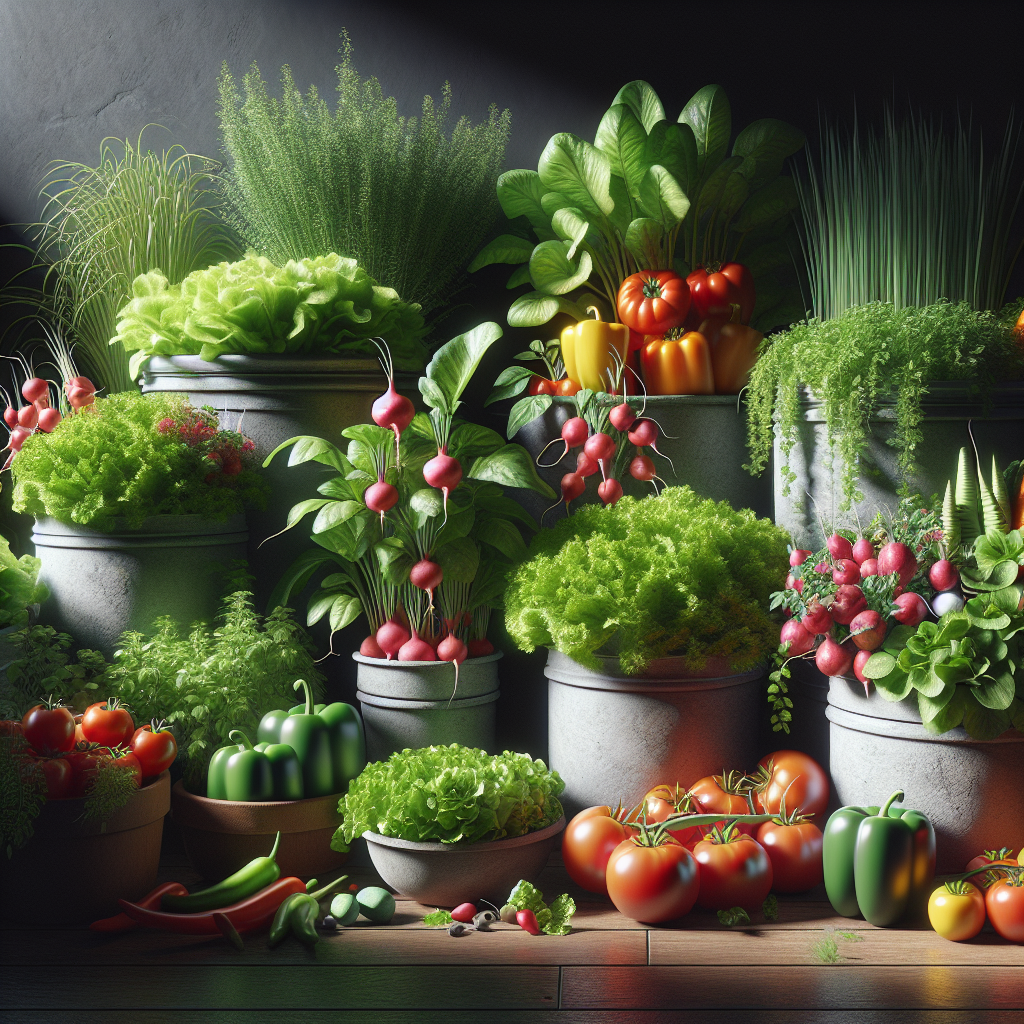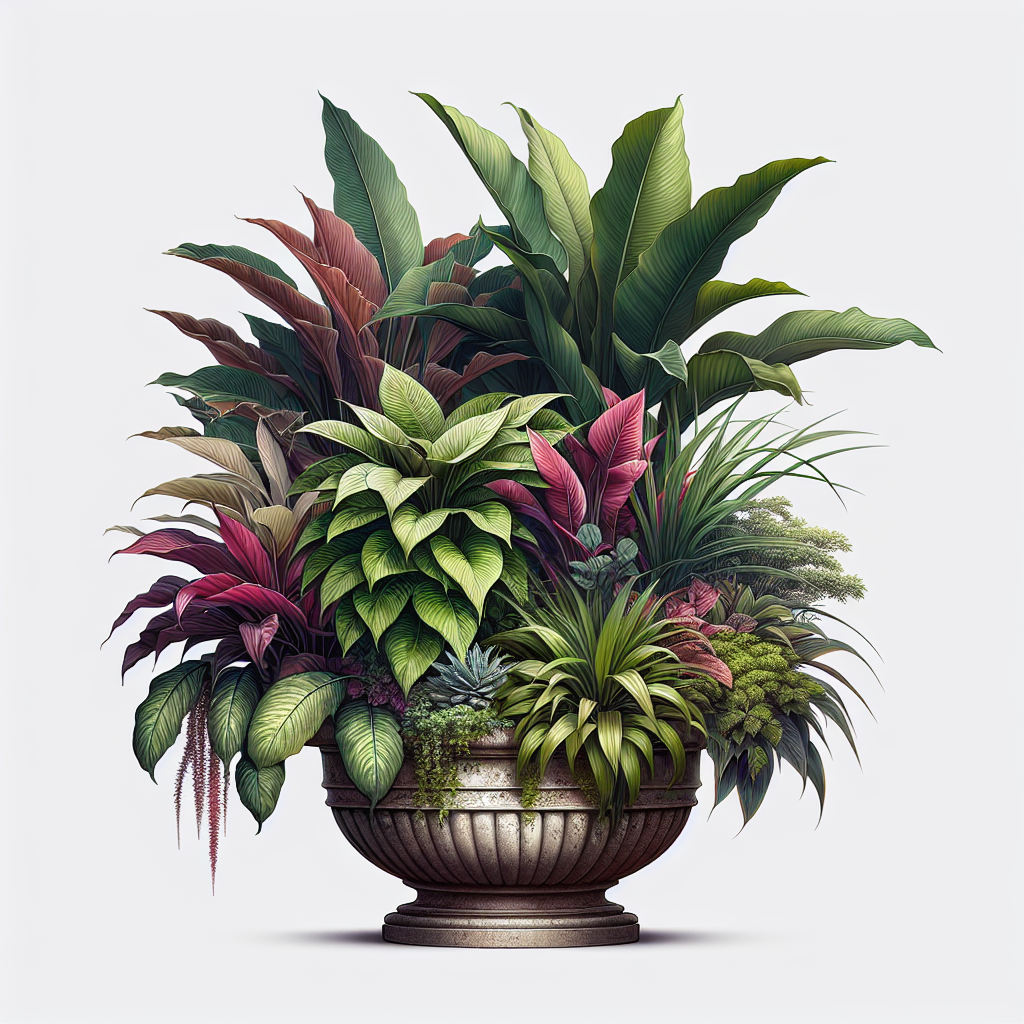Easy Container Gardening Made Simple: Beginner-Friendly Tips and Tricks
October 30, 2024 | by Emma Sage

EASY CONTAINER GARDENING FOR BEGINNERS
11 min read
Discover easy container gardening for beginners with my friendly tips and tricks for urban gardening success!
Container Gardening Basics
Diving into gardening can seem like a big leap, but container gardening makes it all a whole lot easier and enjoyable. I’ve discovered a bunch of reasons to get on board with this approach, especially when city life limits your options.
Why Choose Container Gardening
Container gardening is a smart choice for city folks like me with crummy soil, minimal space, or just the itch to sprinkle some green around the place. You can set up mini-gardens on balconies, patios, or decks—pretty much anywhere! The flexibility is wild—nearly anything I fancy growing can flourish in a well-drained container.
| Reasons to Choose Container Gardening | Description |
|---|---|
| Flexibility | Whether it’s veggies, herbs, or flowers, I can grow them in almost any container as long as it has good drainage. |
| Easiness | As a beginner, it’s ideal because I can start slowly and scale up once I get the hang of it. |
| Portability | It’s a breeze to move my plants to bask in more sun or shield them from the storm. |
Starting out, I found it super cool that my mini-garden can switch spots to chase the sun or dodge the rain, all while working with the nifty space I have.
Benefits of Container Gardening
This style brings oodles of perks. For starters, it turns spots with lousy soil or dim lighting into lush zones. For plant lovers like me without the luxury of a traditional garden, containers are a game-changer.
| Benefits of Container Gardening | Description |
|---|---|
| Diverse Planting Options | I can mix it up with different plants, adding variety and a dash of surprise to my little green world. |
| Enhanced Aesthetics | It’s a cinch to splash some color and life into my outdoor nooks, boosting my home’s curb appeal without a full-scale garden. |
| Effective Space Utilization | Perfect for urban living, I can transform any tiny patch of space into a refreshing garden escape. |
With containers, I’ve crafted my own lush retreat, smack dab in the middle of the city. If you’re just dipping your toes in the gardening waters, swing by our beginner’s guide to container gardening. It’s packed with handy tips to kickstart your green-thumb adventure!

Essential Steps for Beginners
Getting into container gardening has been quite the ride for me, as a newbie. I’ve picked up some tricks along the way, and there are three biggies to keep my plants healthy and thriving: picking the right containers, finding the best soil mix, and selecting the perfect plants.
Selecting the Right Containers
Getting the right container is a game-changer for successful pot gardening. Drainage holes? A must-have! Without ’em, water can build up and send those roots to a mushy doom. I sometimes take matters into my own hands, drilling holes into pots myself if they’re missing. Can’t have root rot crashing the party, y’know?
Now, what about materials? There’s a bunch to choose from like plastic, terracotta, and ceramic. Each has its ups and downs, from keeping temps steady to how easy they are to move around.
| Container Material | Pros | Cons |
|---|---|---|
| Plastic | Light, easy on the wallet | May dry out plants |
| Terracotta | Keeps roots snug, looks nice | Fragile, might leave you high and dry |
| Ceramic | Looks snazzy, keeps the wetness in | Heavy-lifter, not cheap |
Choosing the Ideal Soil Mix
Nailing the soil mix is just as crucial as picking the right pot. Quality potting soil should be fluffy and drain like a charm. I look for a mix with peat moss, perlite, and bark, which makes sure air and water flow just right. Garden soil? Nah, it turns into a muddy mess and suffocates the roots.
Check out the basics for ideal soil ingredients:
| Component | Purpose |
|---|---|
| Peat Moss | Helps hold onto water |
| Perlite | Boosts how water drains |
| Bark | Lets the roots breathe |
Picking the Perfect Plants
Choosing plants is like matchmaking—sun and water needs have to click. I bunch together plants that vibe with similar sunlight and hydration needs, dodging headaches down the line.
If you’re just starting out, try your luck with plants that play nice with beginner green thumbs. Here’s a cheat sheet:
| Easy Plants for Containers | Sunlight Needs | Water Needs |
|---|---|---|
| Herbs (basil, parsley) | Loves the sun | Likes it moderate |
| Cherry tomatoes | Sun worshippers | Drinks regularly |
| Lettuce | Prefers shade | Thirsty for moisture |
Keeping it simple makes container gardening not only fun but super satisfying. If you’re stepping into the world of gardening for the first time, why not peek at the beginner’s guide to container gardening for more tips and tricks?
Best Practices for Container Gardening
Growing plants in pots? Yeah, I’ve gotten pretty good at it over the years. Here’s a glimpse into my little green kingdom. Join me as we talk watering, plant check-ups, and some good old TLC.
Watering and Fertilizing Tips
Plants in pots dry out faster than their buddies in the ground. I play it safe and poke my finger in the dirt. When the top inch feels dry, it’s shower time! Holes in the bottom of the pots are non-negotiable. They stop any chance of drowning our leafy friends.
| Time of Year | How Often to Water |
|---|---|
| Spring | Every 2-3 days |
| Summer | Daily (maybe double up if it’s roasting outside) |
| Fall | Every 3-5 days |
| Winter | Every 7-10 days |
For food, I go for water-mix fertilizers. The label says one thing, but I ignore it—I go halfsies to keep my plants from getting fried. Fertilizer every couple of weeks does the trick during the growing season. Like, tomatoes love a bit of extra phosphorus, and lettuce? It’s all about that nitrogen fix (University of Illinois Extension, Homestead Brooklyn, Almanac).
Monitoring Plant Health
Keeping an eye on my plants is like being in a detective show—minus the trench coat. I’m on the lookout for yellow leaves, droopiness, or unwanted bug parties. A few tweaks with water, sunshine, or plant food usually fixes things.
I sometimes peek at the dirt, too. If it’s hard as a rock or a bit dry, I move them to a new home with fresh potting mix. Good soil is like gold for potted plants—it drains well and holds on to nutrients (Earthbox Blog).
Maintenance and Care Guide
Keeping my little garden thriving needs regular love. Here’s my go-to plan:
- Pruning: Snip, snip! It keeps things growing healthy and disease-free.
- Pulling Weeds: They sneak in everywhere. I yank them out to keep my plants well-fed and hydrated.
- Shifting Homes: If plants outgrow their pots, it’s moving day to a bigger space.
Sticking to these basics, my plants and I have a blast. If you’re curious about growing veggies or herbs in planters, swing by the beginner’s guide to container gardening. Need more veggie or herb-specific tips? Check out the articles on container vegetable gardening for beginners and container herb gardening for beginners.
Vegetables for Beginners
Ever thought about growing your own veggies but live in a concrete jungle with zero space? Container gardening might just be your best friend! You’d be amazed at what you can grow with just a few pots. Let me share some tidbits that got me growing greens right on my windowsill.
Recommended Vegetables for Containers
Not all veggies are created equal, especially when it comes to living in pots. Here’s my shortlist of easy-to-grow vegetables that, in my experience, get along well with containers:
| Vegetable | Container Size Needs |
|---|---|
| Strawberries | 10 inches deep |
| Lettuce | 8 inches deep |
| Cherry Tomatoes | 12 inches deep |
| Peppers | 12 inches or bigger |
Trust me, these guys are not just easy on the eyes but tasty as heck! Snacking on strawberries while watching your favorite show, throwing sweet cherry tomatoes on your salads, or jazzing up dinner with home-grown peppers is the bomb. Wanna dig deeper? Here’s more on container vegetable gardening for beginners.
Tips for Growing Vegetables in Pots
Starting my own container garden was a bit like film school for plants. I picked up a thing or two that I’ll pass on to you:
- Container Size: Bigger is usually better for most plants outdoors, especially if it’s sunny or windy—12 inches or more is a good target. Smaller containers like 4-6 inches work for plants that have modest root systems like lettuce.
- Depth Check: Aim for at least 8 inches depth for most plants. If you’re going big with beets or squash, shoot for around 10 inches to give roots room to party.
- Drain It Right: Remember those school science lessons on plants hating soggy shoes? Make sure your pots have drainage holes. Avoiding swampy roots saved my first batch from total annihilation.
- Sunny Situations: Don’t forget – like us, plants have their light preferences. Some need all the sunshine they can soak up, while others dig the shade. Double-check those trusty plant tags you’ll find when you buy ’em.
- Water and Feed: Keep tabs on your soil’s moisture level because container plants dry up faster than a puddle on a hot day. Water ’em often and give a little extra love with balanced fertilizers for them to grow strong.
Who knew veggie growing could be so straightforward and fun? This little adventure adds a hint of local produce to your meals. Look into the container herb gardening for beginners for some flavorful herbs to mix things up in your kitchen. Get planting and enjoy the ride!
Herb Gardening in Containers
Growing my own herbs right in containers? Count me in! It’s the perfect solution to bringing zesty greens into my kitchen, even when space is tight. Stick around as I share how to do a little gardening in small spots and pick the right homes for my herbs.
Growing Herbs in Limited Spaces
Who knew I could grow herbs almost anywhere? Thanks to containers, I’m growing basil, parsley, mint, and rosemary right on my balcony, patio, or even on a sunny windowsill. These herbs are like my sidekicks, ready to spice up dinner with just a snip.
I’ve discovered that the big secret is sunlight. Most herbs like at least six hours of sunbathing a day. So, I make sure my pots lounge in the sunniest spots. The bonus? These herbs grow faster than a speeding bullet, letting me whip up fresh dishes in no time.
Container Selection and Preparation
Picking the right pots is like finding the perfect pair of shoes—it’s all about the fit. Here’s how I make sure my herbs thrive in their cozy containers:
- Material Choices: I go for containers that look like they belong in nature, like cedar, steel, or terra cotta. These help create a comfy home for my green friends.
- Let it Drain: Nobody likes soggy feet, especially herbs. I always choose pots with drainage holes. When they’re missing, I grab a drill and make them myself.
- Size Does Matter: Room to grow is key. I usually pick containers between 8 to 12 inches, depending on the herb, so each has enough wiggle room.
| Container Size | Ideal Herbs to Grow |
|---|---|
| 8 inches | Basil, Parsley, Cilantro |
| 10 inches | Mint, Chives, Thyme |
| 12 inches | Rosemary, Sage, Oregano |
- Soil Mix: A good soil mix is essential, one that sips water but doesn’t drown. I often sprinkle in some perlite to help air with circulation.
Following these simple steps, I’m growing fresh flavors to jazz up my meals. For more tips to get started on my container gardening adventure, I can check out the beginner guides through these links: Container Gardening for Beginners and Beginner’s Guide to Container Gardening.
Common Mistakes to Avoid
When I dipped my toes into the world of container gardening, boy, did I learn the hard way! Avoiding a few key blunders can really spruce up your gardening game, and I’m here to share all the goofs I’ve encountered, plus some handy tricks to get around them.
Key Mistakes in Container Gardening
- Botching the Drainage
My first goof was picking pots that might as well have been sinks—no proper drainage holes! Water pooled, roots drowned, and my poor plants keeled over. Always grab pots with holes at the bottom, or get your drill out if you’re feeling crafty and your pots are lacking (Proven Winners). - Using Junk as Fillers
I thought I could cut costs by chucking rocks and broken bits into the base of my pots to save on soil. Big no-no! These fillers backfire by keeping water stuck and turning your plant’s life into a soggy mess (Proven Winners). - Dousing Plants with Too Much Love
I’ve dumped buckets of love—er, water—onto my container plants, thinking they were like ground soil. But guess what? Container plants get thirsty faster, yes, but they’re also easy to drown. I now give them a drink only when that top inch of soil feels dry and keep an eye on drainage (University of Illinois Extension). - Overlooking Plant Growth Habits
It was a jungle out there before I understood that plants have growth habits. Like putting tall rosemary smack in front was a light hogging disaster for smaller buddies like thyme. Now, the tall folks chill out in the back so everyone gets their fair share of sunshine (Journey with Jill). - Not Playing Matchmaker for Plants
At first, I didn’t rate pairing plants based on friendship needs. Turns out, plants like mint drink more, so mixing and pairing with plants that have similar thirst levels keeps them all happy and lively (Journey with Jill).
How to Prevent and Overcome Mistakes
I’ve picked up a few moves to make my garden groove:
- Drainage Duty: I always check those drainage holes like an eagle-eyed detective to keep them open and flowing right.
- Watering 101: I stick my finger in the top soil to see if it’s dry before giving any water, keeping my plants quenched but not drowned.
- Master the Plant Arrangement: I sketch out where everyone goes in the pot, ensuring height and spread are friendly and peaceful.
- Study Plant Friendships: Learning which plants vibe together, especially when it comes to what they drink, makes a world of difference.
- Get the Good Dirt: Investing in solid potting mix is like serving up a five-course meal for my plants with all the richness and drainage they crave.
Dodging these errors and using these little tricks have made my container garden a real looker that’s easy to handle. So whether you’re just starting out or polishing your green thumb, these tips should get you kitted for success in your own easy container gardening for beginners.
Happy gardening,
Emma Sage
RELATED POSTS
View all



